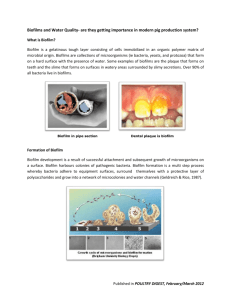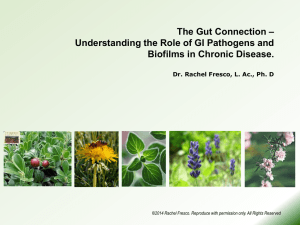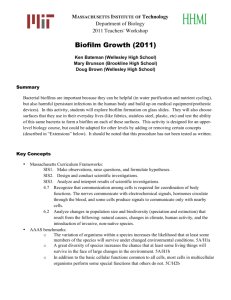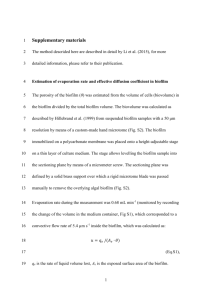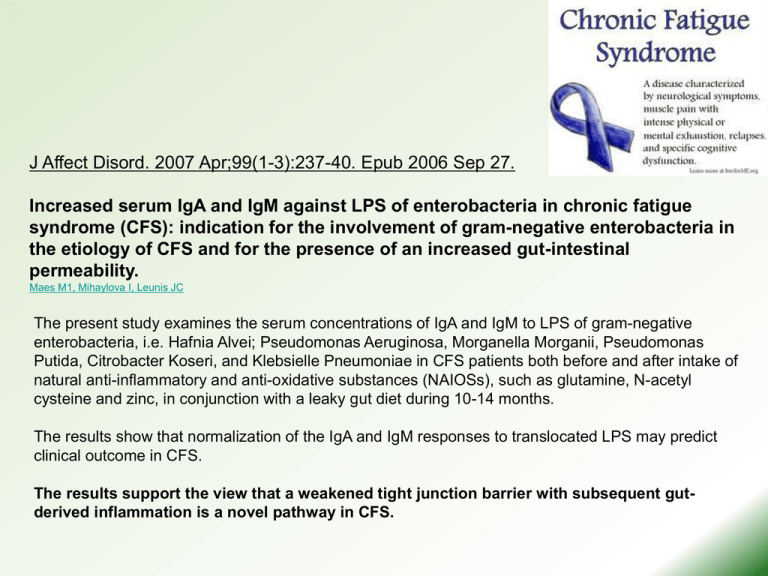
J Affect Disord. 2007 Apr;99(1-3):237-40. Epub 2006 Sep 27.
Increased serum IgA and IgM against LPS of enterobacteria in chronic fatigue
syndrome (CFS): indication for the involvement of gram-negative enterobacteria in
the etiology of CFS and for the presence of an increased gut-intestinal
permeability.
Maes M1, Mihaylova I, Leunis JC
The present study examines the serum concentrations of IgA and IgM to LPS of gram-negative
enterobacteria, i.e. Hafnia Alvei; Pseudomonas Aeruginosa, Morganella Morganii, Pseudomonas
Putida, Citrobacter Koseri, and Klebsielle Pneumoniae in CFS patients both before and after intake of
natural anti-inflammatory and anti-oxidative substances (NAIOSs), such as glutamine, N-acetyl
cysteine and zinc, in conjunction with a leaky gut diet during 10-14 months.
The results show that normalization of the IgA and IgM responses to translocated LPS may predict
clinical outcome in CFS.
The results support the view that a weakened tight junction barrier with subsequent gutderived inflammation is a novel pathway in CFS.
LPS, Zonulin and Systemic
Inflammation:
Intestinal Dysbiosis and Leaky Gut Syndrome
Clinical Goals:
① Eliminate GI Dysbiosis due to pathogenic bacteria, yeast, fungus and parasites.
② Address biofilms and systemic infections, reduce LPS, LTA translocation
③ Eliminate allergens from the diet.
④ Support detoxification: liver and toxic metals, LPS burden
⑤ Raise antioxidants such as glutathione.
⑥ Support beneficial organisms with pre and probiotics.
⑦ Heal gut lining with Vit D-3, glutamine, other support supplements
These are really fundamental protocols in any patient with chronic inflammation or any
long term illness.
Antibiotic Therapy
Can be life-saving,
however…
Overuse has lead to resistant
strains and pollution of the
environment.
Are often ineffective in Biofilm and
“superbug”related infections
May disturb normal GI flora,
causing overgrowth of yeast or
bacteria, as seen in C. Difficile
infection
Research suggests botanicals may
assist antibiotic effectiveness
Antibiotics known to cause
C. Difficile:
Clindamycin
Ampicillin
Amoxicillin
Cephalosporins
Occasionally cause C. Difficile:
Penicillin
Erythromycin
Ciprofloxacin
Biofilm Control:
Utilizing Plant Based Medicines
•
Inhibition of Quorum Sensing
•
Inhibition of Initial Attachment Phase of
Biofilm Colonies
•
Inhibition of Swarming Motility
•
Multi-Drug Resistance Pump Inhibitors
•
Bacteriostatics / Bactericidals
24 hour Exposure to Botanical Combination
Inhibition of Quorum Sensing
Cell signaling by organisms using auto inducers called
Quorum Sensing determines gene expression,
virulence, resistance, and the development of biofilms.
Botanicals which
are known to inhibit
Quorum Sensing:
-
Garlic
Oregano
Bilberry
Bladderwrack
Essential Oils:
Prevention Adhesion and Disrupting or
Destroying Biofilm Components
Phenolics such as Thymol interact with surface proteins of bacteria, leading to an
alteration of the cell surface and interrupt the initial attachment phase of biofilm
formation.
Essential Oils may prove to be most useful in treating multi drug resistant gram
negative bacteria such as Pseudomonas, Escherichia and Acinetobacter.
Condensed Tannins:
Powerful OPC’s Control Biofilm Development by
Inhibition of Swarming Motility of Pathogenic
Organisms
Grape Seed and Bilberry contain condensed
tannins that prevent adherence of biofilms,
and may inhibit swarming motility of
bacteria.
OPC’s are also potentiators for Vit C,
providing numerous benefits in cellular
health and anti-aging medicine.
Representative images of P. aeruginosa swarming
motility under control conditions (A) and in the
presence of Cranberry (B) and Pomeranate (C) (both
100 μ/ml).
Efflux Pump Inhibitors:
Inhibition of Multi Drug Resistance Pumps
Tannins, berberine, and certain phenolics have
useful effects as efflux pump inhibitors.
Research indicates that these botanicals can
potentiate conventional antibiotics and increase
their effectiveness against a variety of both
gram positive and gram negative organisms.
Goldenseal, Black Walnut, White Willow,
Raspberry Leaf Bladderwrack, Uva Ursi, and
Garlic are a few botanicals that have been
studied as Efflux Pump Inhibitors.
Formulation Rationale for
Botanical Combinations:
•
Only medical grade botanicals
contain enough of the active
ingredients to be clinically
effective.
•
Like a symphony, individual
components must be in
harmony.
•
The goal in formulation is
achieved when a maximum
result is produced without
stressing the body or causing
unwanted side effects.
Combination Botanical
Formulas
•
Broad Spectrum of activity against gram positive and gram
negative bacteria, yeast, fungus, parasites and viruses.
•
Inhibition of biofilms through more than one mechanism of
action.
•
Acts both systemically and in the digestive system, and may be
used in acute or chronic infection.
•
Contains immune system modulators to up-regulate the body’s
own defenses.
•
Supports clearance of toxins through activation of drainage
pathways of the liver and kidneys.
•
Reduces inflammation and promotes healing of tissues to reverse
damage due to leaky gut.
•
A synergistic blend to produce desired results without side
effects or stress on organ systems.
Botanical Combination Formulas Address:
Dysbiosis and Leaky Gut
Candida
Lyme and co-infections
Skin infections
Viral
conditions
Upper respiratory infection
Dental/Gum infection
Urinary tract infection
Prostate inflammation
Auto-immune disease
Elderly or at risk individuals
During heavy metal chelation
Adjunct to cancer treatments
Any acute or chronic infection
USP Effectiveness
Testing of Botanical
Combination
Demonstrates inhibitory activity of
against both gram positive and
gram negative bacteria, yeast and
fungus.
Bilberry extract, Grape Seed extract,
Milk Thistle, Echinacea, Goldenseal,
Shiitake, White Willow, Garlic, Black
Walnut (hull and leaf), Raspberry,
Fumitory, Gentian, Noni, Tea Tree oil,
Galbanum oil, Lavender oil, Oregano oil
Text
Text
Bacteriostatic and Bactericidal
Botanicals
Bacterostatics: Prevent Replication of
Bacteria.
Berberine containing plants such as Goldenseal and
Gentian have demonstrated powerful bacteriostatic
action.
One study showed the effectiveness of berberine
against Staph. epidermidis, one of the most
common causes of skin infections. Sub-minimal
inhibitory concentrations block the formation of S.
epidermidis biofilm.
Bactericidals: Terminate Bacteria
Olive Leaf , Goldenseal, Bilberry, Grape Seed,
Shiitake, Noni, Black Walnut, Garlic, Gentian and
Fumitory are potent bactericides. Oregano, Tea
Tree , Lavender and Galbanum oils are essential
oils with excellent antimicrobial activity.
Combining Antimicrobial
Ingredients Provides Maximum
Effectiveness
•
•
•
Goldenseal
Contains Berberine with broad antimicrobial activity. Berberine
has also been shown to kill a wide range of organisms, such
as those that cause candida (yeast) infections, viruses, and
various parasites such as tapeworms and Giardia. Berberine
may also activate white blood cells, making them more
effective at fighting infection and strengthening the immune
system, in addition to helping to remove biofilms.
Gentian
Used to purify the blood since discovered around 167 B.C.,
Gentian is a digestive bitter. It also increases the activity of the
liver and gall bladder to improve their function, and is used to
improve absorption of nutrients, especially iron. Like
Goldenseal it also contains Berberine with a broad spectrum
of activity.
Echinacea Angustifolia and Purpurea
Contains active substances that enhance the activity of the
immune system, relieve pain, reduce inflammation, and have
antiviral, and antioxidant effects.
Combining Antimicrobial Ingredients
Provides Maximum Effectiveness
•
•
•
Olive Leaf
In vitro studies have shown that Oleuropein can inhibit
the growth of viruses, bacteria, fungi and parasites via
complex and novel methods including the inhibition of
enzymes necessary for bacterial growth and weakening
the cell wall of pathogens.
Garlic
A potent antioxidant and antimicrobial, garlic has been
used as medicine for thousands of years. Recent
research points to it’s cardiovascular benefits, anticancer properties and immune enhancing properties,
including inhibition of MDR pumps and Quorum
Sensing.
Black Walnut
Containing valuable tannins Black Walnut is not only
anti-parasitic but also anti-fungal, anti-viral and
antimicrobial. Extract of black walnut is reported to treat
eczema, herpes, psoriasis, fungal infections, and both
skin and internal parasites.
Medical Grade Essential Oils
•
•
•
•
Oregano
Oil of Oregano contains two key compounds, carvacrol and thymol.
Studies have shown that both of these compounds have significant
effects on harmful microorganisms and biofilm infections. In addition,
thymol can reduce bacterial resistance to common drugs such as
penicillin. Thymol has been shown to be an effective fungicide,
particularly against fluconazol (Difucan)-resistant strains. This is
especially relevant given that opportunistic Candida can cause severe
systemic infections.
Tea Tree
The oil has beneficial medical properties including antiseptic, antifungal
and antibacterial, actions. Tea tree oil has been used topically against
Staph including MRSA.
Lavender
Essential oil of lavender has antiseptic and anti-inflammatory properties.
It was even used to disinfect hospitals during WWI. Lavender oil is
extensively used for various respiratory infections, and has a calming
effect on the nervous system.
Galbanum
Mentioned in the Old Testament, as well as by Hippocrates, Galbanum
has one of the oldest recorded histories of beneficial use. It is both
antimicrobial and anti-parasitic and is traditionally used for healing
wounds and in the treatment of infection both internally and externally.
Detoxification Pathway Support
Removes Toxins and Decreases
Herxheimer Reactions, Supports Removal
of Biofilms
•
•
•
Dandelion
Although maligned as a lowly weed, dandelion has
numerous cleansing properties. It supports the liver and
kidneys and is a diuretic, allowing toxins to be eliminated.
The fresh juice may be applied directly to wounds The
leaves are high in minerals and vitamins.
Uva Ursi
A useful diuretic and antimicrobial, Uva Ursi contains plant
tannins that assist in removal of biofilm related infections,
and is often used to treat UTI.
Bladderwrack
A seaweed know for supporting thyroid function,
Bladderwrack also contains Fucoidan, which may prevent
adhesion of bacteria and viruses, also helping prevent
biofilm colonies from developing.
Immune Modulators
Increase Overall Immune System Activity,
Rejuvenate and Invigorate the Action of
Immune Cells.
•
•
•
Shiitake
Shiitake has numerous health benefits. Lymphokines, such as
interferon and interleukin stimulate the defense system,
increasing the number of phagocytes including macrophages
and other immune fighters that attack cancer cells, bacteria,
and viruses. Shiitake also has potent antibiotic effects against
other organisms.
Noni
Noni juice is an ancient health beverage possessing immune
stimulating, anticancer, antibacterial, anti-fungal, and anti-aging
properties. Several phytochemicals have been isolated from
noni fruit indicating potential anti-inflammatory activity. Noni
contains various powerful antioxidants that prevent free radicals
from damaging cells.
Cordyceps
The Cordyceps mushroom has a long history as medicinal
fungi. The earliest clear record is a Tibetan medical text in the
15th Century outlining the tonic properties. Recent research
has verified its’ unique healing capacity.
Antioxidants Quench Free Radicals
Powerful Extracts Increase Cellular Integrity and
Prevent Oxidative Stress, Inflammation and Tissue
Destruction.
•
Bilberry
Bilberries contain one if the highest levels of OPC’s and help
formation of and strengthening of connective tissue and
capillaries, and are used for ocular health. The anti-inflammatory
properties have also been helpful GI Dysbiosis. Bilberries inhibit
or kill fungi, bacteria, and protozoans.
•
Grape Seed Extract
Grape Seed Extract is another natural bioflavonoid which helps
strengthen and protect cell membranes from oxidative damage.
Catechins help reduce allergic responses by inhibiting enzymes
involved in the formation of histamine.
•
Raspberry
The fruit is high in ellagic acid, a phenolic compound that may
help prevent cancer and helps to stop biofilm formation.
Raspberry leaves are known historically for the treatment of
diarrhea. In addition, raspberry leaves can be used to treat
wounds, ulcers, and dental infections.
Clinical Goals Review:
① Eliminate GI Dysbiosis due to pathogenic bacteria, yeast,
fungus and parasites.
② Address biofilms and systemic infections, reduce LPS, and
LTA translocation
③ Eliminate allergens from the diet.
④ Support detoxification: liver and toxic metals, LPS burden
⑤ Raise antioxidants such as glutathione.
⑥ Support beneficial organisms with pre and probiotics.
⑦ Heal gut lining with Vit D-3, glutamine, other support
supplements
These are the fundamental protocols in any patient with chronic
inflammation or any long term illness.
©2014 Rachel Fresco. Reproduce with permission only. All Rights Reserved


